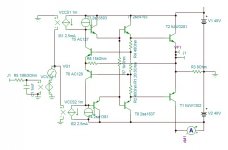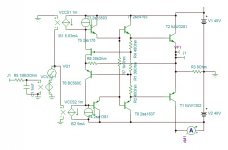Yes, but what I don't like with such a solution is the lack of symmetry.It looks like bias setting pot for Elvee's silicone version works OK in this location.
OK, it is a bit of maniac obsession, but I prefer nice, balanced circuit, even if they aren't really required
https://www.diyaudio.com/forums/att...3d1594929669-unusual-amp-1987-a-captureap-jpgI remember I built this in the early 90's ... I was a student and I didn't have money - so it was never finished (no enclosure etc) , but it sounded good, as far as I remember
This amp uses Single Floating Supply, a decade before Onkyo, three decades before my presumed invention. The input error stage VT1,VT2, can be replaced by Rush cascode advantageously. It uses current bias, but what controls the crossover? I will simulate to find out. It might be possible to make it non-switching.
https://www.diyaudio.com/forums/att...3d1594929669-unusual-amp-1987-a-captureap-jpg
This amp uses Single Floating Supply, a decade before Onkyo, three decades before my presumed invention. The input error stage VT1,VT2, can be replaced by Rush cascode advantageously. It uses current bias, but what controls the crossover? I will simulate to find out. It might be possible to make it non-switching.
The crossover is controlled by a deep GNFB. Partially VT7, VT8 - voltage controlled current shunt.
Original article
Стр. 57 журнала <<Радио>> № 10 за 1989 год
Last edited:
https://www.diyaudio.com/forums/att...3d1594929669-unusual-amp-1987-a-captureap-jpg
This amp uses Single Floating Supply, a decade before Onkyo, three decades before my presumed invention. The input error stage VT1,VT2, can be replaced by Rush cascode advantageously. It uses current bias, but what controls the crossover? I will simulate to find out. It might be possible to make it non-switching.
I'm assuming it would work equally well with traditional rails, right?
I guess there must be a reason no one uses floating rails in current designs..
Last edited:
Does anyone have problems with replying to posts and quoting them?
For most posts, if I hit "REPLY" button, the body of the message is blank.
Only in 1 in 10 cases, the previous post would be quoted in the web form.
It's been like for a week or two...

We changed it deliberately to try and stop the constant posting of the post immediately above.
Multi-Quote This Message Button
Single supply has been used before, by Quad most notably, and IIRC in RCA application sheets amongst others.This amp uses Single Floating Supply, a decade before Onkyo, three decades before my presumed invention.
Since the only advantage is the absence of a CT on the transformer, it is now disregarded (Quad used a low-power supply balancer to keep a control on the synthetic ground, which added some components to the BOM).
It is possible to use the amplifier itself as a supply splitter/balancer, but there is no need to resort to such acrobatics when a CT is almost free
It is probably possible to operate the circuit in a non-switching mode: I have used a similar topology to that end.The crossover is controlled by a deep GNFB. Partially VT7, VT8 - voltage controlled current shunt.
The Single Floating Supply is not a usual single supply described by Elvee, It is used in most prestigious models of Onken. This type of floating supply enters in the feedback loop of the amplifier which decreases dramatically the impedance of the power supply, producing much more powerful bass compared to split type, and without armada of reservoir capacitors . The dark side, it requires individual isolated one for each channel. On the other hand it doesn't need speaker protection.I'm assuming it would work equally well with traditional rails, right?
I guess there must be a reason no one uses floating rails in current designs..
I am analyzing only the output stage. It is indeed a current biased. If I ground the output, the current has very low distortion with push pull input current. The problem I am looking for, what making it distorted when I let the output voltage swing. The Early is not the main cause.
The spice model I found for GT308b has Vbe threshold of 0.8v instead of 0.2v, so I am using the AC128.
Hayk
The spice model I found for GT308b has Vbe threshold of 0.8v instead of 0.2v, so I am using the AC128.
Hayk
this one I posted earlier?
.model GT308B pnp bf=800 br=.3 eg=0.72 cje=20p cjc=15p tf=1n tr=.4u xcjc=0.4 is=100n ikf=45m vaf=30 mje=0.5 mjc=0.5 rc=20 rb=80 rbm=10 irb=1m ise=25n ne=1.5 isc=.7u nc=1.4 mfg=GERMANIUM_USSR
If you are interested in Soviet amps, there was a great sounding high end amplifier back in 1985, the Corvette 048. https://forum.cxem.net/uploads/monthly_07_2012/post-65402-0-40398400-1342414912.gif
http://rw6ase.narod.ru/00/us_b/korwet_um048s.jpg
Art Audio Корвет 100УМ-048С - YouTube
http://rw6ase.narod.ru/00/us_b/korwet_um048s.jpg
Art Audio Корвет 100УМ-048С - YouTube
Last edited:
Very interesting amp!If you are interested in Soviet amps, there was a great sounding high end amplifier back in 1985, the Corvette 048.
Here is a nice repository of Soviet amps:
Amplifiers - Russian vintage electronics
Last edited:
This klass G.
Klass AB Korvet-038
Нужна помощь в возрождении усилителя Корвет УМ 038 стерео - Песочница (Q&A) - Форум по радиоэлектронике
Klass AB Korvet-038
Нужна помощь в возрождении усилителя Корвет УМ 038 стерео - Песочница (Q&A) - Форум по радиоэлектронике
Corvette 100UM-048S was produced in three modifications of amplifiers. The diagrams show that the power transformers and output stages are different. Corvette 100UM-048S also class AB. Corvette 068 class G. For the first time, a LAN-class power amplifier with two-level power supply was used here, which made it possible to improve the thermal regime of the amplifier.
Korvet 100U-068S - Russian vintage electronics I also had it, it sounded much worse.
Korvet 100U-068S - Russian vintage electronics I also had it, it sounded much worse.
Last edited:
- Home
- Amplifiers
- Solid State
- Unusual amp from 1987

